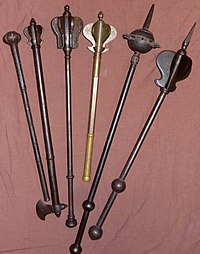Mace
| Mace | |
|---|---|

|
|
| Information | |
| Weapon type: | Mace |
| Use: | Weapons of war, foot troops, cavalry troops |
| Creation time: | circa 11th century |
| Working time: | approx. 11th - 17th century |
| Region of origin / author: |
Arabia |
| Distribution: | Europe , North Africa |
| Overall length: | approx. 120 cm |
| Weight: | > 1.5 kg |
| Handle: | Wood, metal |
| Particularities: | different head shapes |
| Lists on the subject | |
The mace (formerly also Slegel , Schlegel or mallet is called), a further development of the leg and made of a metal or wooden shank and a generally symmetrical impact head made of stone or metal. Maces belong to the category of balancing weapons because they do not penetrate the body when used. However, there are also maces with sharply ground flaps, which are classified as cutting weapons because they penetrate the body when they are used.
description
The Mace was already in the Upper Paleolithic from the club developed and was widely used, such as in ancient Egypt .
In the Middle Ages , the mace was used as a weapon in the cavalry . However, it was also used in the infantry ; so z. B. with the " Men-at-Arms ", who wielded such weapons in the Battle of Crecy . Maces could also have thorns. They could either be made entirely of metal or made of wood with metal fittings. An extreme form of the piston is the so-called “Goedendag”.
The mace had a great effect on armor . At the beginning of the High Middle Ages , the mace was frowned upon by the French knights in particular , as only lance and sword were considered knightly weapons for them . There is a parallel here to other weapons such as battle ax , battle hammer and flail . These simple weapons were perceived as unknightly because on the one hand they resembled profane tools , on the other hand they looked simply clumsy and inelegant. In addition, these weapons were significantly cheaper to manufacture than a sword, so they did not offer the desired exclusivity for the nobility . With the advent of better and better armor, however, swords lost more and more of their effectiveness, whereas balancing weapons were also effective against plate armor . Therefore, despite its low reputation, this type of weapon was used more and more often.
In the 16th century (with the proliferation of firearms and the decline in heavy armor) the mace gradually fell out of use, but maces are still used as ceremonial weapons in some countries. For example, the Serjeant-at-Arms , the master of ceremonies in the British House of Commons , and the deans of most American and British universities have ceremonial maces. Particularly magnificent models were also used as status symbols by cavalry generals and rulers as sceptres . From this the marshal's baton developed .
See also
literature
- André Schulze (Hrsg.): Medieval ways of fighting. Volume 2: The War Hammer, Shield and Piston. Talhoffers Fechtbuch anno domini 1467. von Zabern, Mainz 2007, ISBN 978-3-8053-3736-6 .
- Martin J. Dougherty: Weapons and fighting Techniques of the medieval warrior, 1000-1500 AD. Amber Books Ltd., London 2008, ISBN 978-1-906626-06-8 (German edition: War Art in the Middle Ages. Equipment and fighting techniques from 1000 to 1500 AD. Weltbild, Augsburg 2008, ISBN 978-3-8289-0861 -1 ).
Web links
- Mace, Germany around 1550, type M2 after Oakeshott, formerly the Prince of Hohenzollern-Sigmaringen collection
- Even knights valued the oldest weapon known to man
Individual evidence
- ↑ mallet , m . - Section: 1 b). In: Jacob Grimm , Wilhelm Grimm (Hrsg.): German dictionary . tape 15 : Schiefeln – Soul - (IX). S. Hirzel, Leipzig 1899, Sp. 340 ( woerterbuchnetz.de - club, as a weapon).